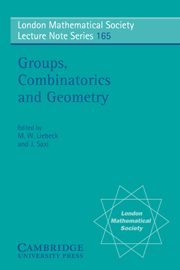Book contents
- Frontmatter
- Contents
- Authors' Addresses
- Introduction
- Part 1 Sporadic groups
- Part 2 Moonshine
- Part 3 Local and geometric methods in group theory
- Part 4 Geometries and related groups
- 17 Finiteness questions for geometries
- 18 Kac-Moody groups and, their automorphisms
- 19 Generalized hexagons as geometric hyperplanes of near hexagons
- 20 On simplicial complexes related to the Suzuki sequence graphs
- 21 Twin buildings and groups of Kac-Moody type
- Part 5 Finite and algebraic groups of Lie type
- Part 6 Finite permutation groups
- Part 7 Further aspects of simple groups
- Part 8 Related topics
21 - Twin buildings and groups of Kac-Moody type
Published online by Cambridge University Press: 07 September 2010
- Frontmatter
- Contents
- Authors' Addresses
- Introduction
- Part 1 Sporadic groups
- Part 2 Moonshine
- Part 3 Local and geometric methods in group theory
- Part 4 Geometries and related groups
- 17 Finiteness questions for geometries
- 18 Kac-Moody groups and, their automorphisms
- 19 Generalized hexagons as geometric hyperplanes of near hexagons
- 20 On simplicial complexes related to the Suzuki sequence graphs
- 21 Twin buildings and groups of Kac-Moody type
- Part 5 Finite and algebraic groups of Lie type
- Part 6 Finite permutation groups
- Part 7 Further aspects of simple groups
- Part 8 Related topics
Summary
Introduction
The combinatorial objects called buildings were first introduced (cf.) to provide a geometric approach to complex simple Lie groups – in particular the exceptional ones – and later on, more generally, to isotropic algebraic simple groups (cf. eg.). The buildings which do arise in that way are spherical, that is, have finite Weyl groups. This assertion has a partial converse, proved in: roughly speaking, there is a one-to-one correspondence between the (isomorphism classes of) buildings of irreducible spherical type and rank r ≥ 3 and the algebraic absolutely simple groups of relative rank r, where the notion of algebraic simple groups must be suitably extended so as to include, for instance, classical groups over division rings of infinite dimension over their centre. In order to have a similar statement in the rank 2 case, one must impose an extra condition, the Moufang condition, on the buildings under consideration.
The correspondence in question is established via the classification of buildings of irreducible, spherical types and rank ≥ 3. For non-spherical buildings, a full classification is known only for the affine types, in rank ≥ 4 (cf.): buildings of such a type have a “spherical building at infinity”, which is the essential tool for classification. A construction procedure for buildings of more general types given in shows that there cannot be any hope for a complete classification of buildings of arbitrary types. On the other hand, there is another wide class of groups, the Kac-Moody groups, which give rise to buildings, usually of non-spherical and non-affine types; these are “concrete” objects, which one also wishes to characterize geometrically.
- Type
- Chapter
- Information
- Groups, Combinatorics and Geometry , pp. 249 - 286Publisher: Cambridge University PressPrint publication year: 1992
- 40
- Cited by



